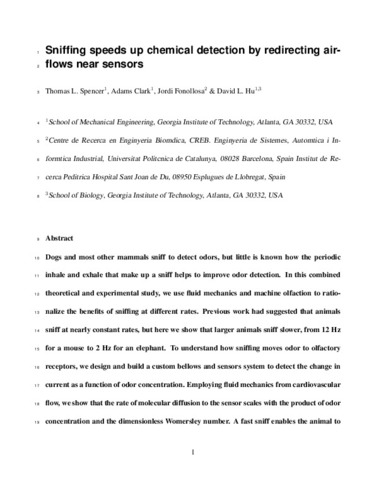Exploració per tema "Nas electrònic"
Ara es mostren els items 1-11 de 11
-
Application of manifold learning algorithms to improve the classification performance of an electronic nose

(Institute of Electrical and Electronics Engineers (IEEE), 2019)
(Institute of Electrical and Electronics Engineers (IEEE), 2019)
Text en actes de congrés
Accés restringit per política de l'editorialThe problem of classification and the use of robust methodologies in electronic nose sensor arrays applications are still open. Among the several steps in the developed method- ologies, it is clear that feature extraction ... -
Bioinspired early detection through gas flow modulation in chemo-sensory systems

(2015-01-01)
(2015-01-01)
Article
Accés obertThe design of bioinspired systems for chemical sensing is an engaging line of research in machine olfaction. Developments in this line could increase the lifetime and sensitivity of artificial chemo-sensory systems. Such ... -
Biomimetic set up for chemosensor-based machine olfaction


(Universitat Politècnica de Catalunya, 2014-12-04)
(Universitat Politècnica de Catalunya, 2014-12-04)
Tesi
Accés obertThe thesis falls into the field of machine olfaction and accompanying experimental set up for chemical gas sensing. Perhaps more than any other sensory modality, chemical sensing faces with major technical and conceptual ... -
Canine-inspired unidirectional flows for improving memory effects in machine olfaction

(Oxford University Press, 2023-08-23)
(Oxford University Press, 2023-08-23)
Article
Accés restringit per política de l'editorialA dog's nose differs from a human's in that air does not change direction but flows in a unidirectional path from inlet to outlet. Previous simulations showed that unidirectional flow through a dog’s complex nasal passageways ... -
Kullback–Leibler importance estimation procedure to improve gas quantification in an electronic nose

(2022-12-15)
(2022-12-15)
Article
Accés obertAn electronic nose sensor array can classify and quantify different types of gases; however, the sensor can alter its measurement capability over time. The main problem presented during the measurements of the sensors is ... -
Machine learning methods in electronic nose analysis

(2016)
(2016)
Text en actes de congrés
Accés obertThe main existent tool to monitor chemical environ- ments in a continuous mode is gas sensor arrays, which have been popularized as electronic noses (enoses). To design and validate these monitoring systems, it ... -
Odour mapping under strong backgrounds with a metal oxide sensor array

(American Institute of Physics (AIP), 2011)
(American Institute of Physics (AIP), 2011)
Text en actes de congrés
Accés obertThis text describes the data from an initial set of navigation experiments in the scope of the Bio-ICT European project NEUROCHEM (...) This poster shows that a preprocessing based on Independent Component Analysis is able ... -
Pulsed-temperature metal oxide gas sensors for microwatt power consumption

(Institute of Electrical and Electronics Engineers (IEEE), 2020-01-01)
(Institute of Electrical and Electronics Engineers (IEEE), 2020-01-01)
Article
Accés obertMetal Oxide (MOX) gas sensors rely on chemical reactions that occur efficiently at high temperatures, resulting in too-demanding power requirements for certain applications. Operating the sensor under a Pulsed-Temperature ... -
Smart Sensors

(Elsevier, 2020-06-02)
(Elsevier, 2020-06-02)
Capítol de llibre
Accés restringit per política de l'editorialCalibration costs still limit the mass deployment of smart systems based on low-cost chemical sensors. Recent cost-efficient calibration strategies skip the acquisition of a full set of calibration samples when building ... -
Sniffing speeds up chemical detection by controlling air-flows near sensors

(2021-12-01)
(2021-12-01)
Article
Accés obertMost mammals sniff to detect odors, but little is known how the periodic inhale and exhale that make up a sniff helps to improve odor detection. In this combined experimental and theoretical study, we use fluid mechanics ... -
Synthetic benchmarks for machine olfaction: Classification, segmentation and sensor damage

(Elsevier, 2015-06-30)
(Elsevier, 2015-06-30)
Article
Accés obertThe design of the signal and data processing algorithms requires a validation stage and some data relevant for a validation procedure. While the practice to share public data sets and make use of them is a recent and still ...









